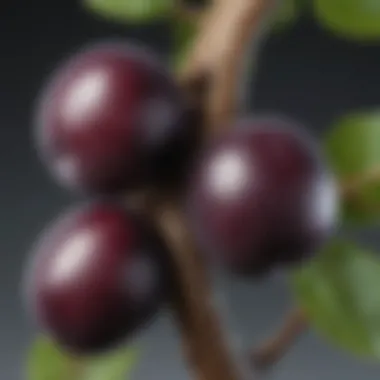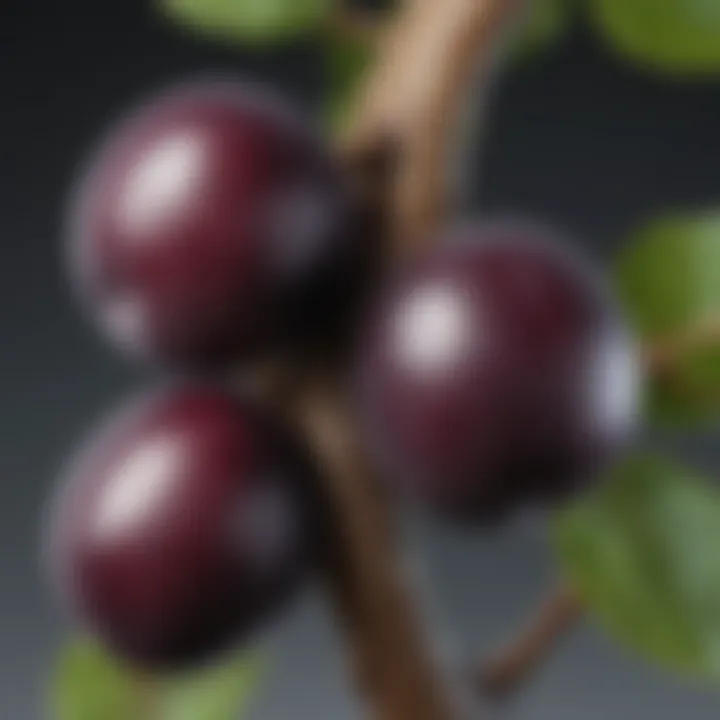Understanding Plum Tree Diseases and Their Management


Overview of the Topic
Definition and Importance
Plum trees, cherished for their lush foliage and succulent fruits, are not just a staple in home gardens but also significant for commercial orchards across various regions. However, these trees are not immune to diseases that can threaten their vitality and productivity. The study of plum tree diseases entails exploring the challenges that farmers and horticulturists face. This understanding is vital, as it allows for the identification of symptoms early on, leading to effective management and mitigation.
Plum tree diseases arise from a combination of plant pathogens and unfavorable environmental conditions. Different ailments can lead to a range of repercussions, from reduced fruit quality to tree death. Whether one tends to a small personal garden or manages a large commercial orchard, grasping the nuances of these diseases can spell the difference between a flourishing harvest and a complete crop failure.
Current Trends
In recent years, there has been a notable shift toward sustainable farming practices that prioritize ecological balance. More farmers are turning to organic methods for disease management, relying on natural predators or environmentally friendly fungicides to maintain healthy plum trees. Additionally, the integration of technology, such as soil sensors and disease forecasting models, has enhanced the ability to predict and combat plum tree diseases before they escalate.
As climate change impacts global gardening practices, understanding how environmental shifts affect disease prevalence has become an urgent topic. Monitoring weather patterns, soil moisture levels, and pest populations are now integral parts of disease management.
Key Techniques and Practices
Step-by-Step Guide
Managing plum tree diseases effectively can be approached in several systematic steps:
- Regular Inspections: Check your trees weekly during the growing season for any signs of illness. Look for unusual leaf spots, wilting, or discoloration.
- Soil Health Assessment: Test the soil every few years to ensure it contains the necessary nutrients that promote robust growth. This can prevent stress that makes trees more susceptible to diseases.
- Pruning and Thinning: This is essential for improving air circulation and light penetration. Prune out any diseased limbs promptly to prevent the spread of pathogens.
- Water Management: Overwatering can lead to root diseases. Ensure good drainage and water trees according to their specific needs.
- Disease-Specific Treatments: When diagnosing a particular disease, apply appropriate treatments, whether organic solutions like neem oil or chemical fungicides, as needed.
Tools and Equipment Needed
Investing in the right tools can make a significant difference in managing plum tree diseases:
- Pruning Shears: For cutting away diseased limbs.
- Soil Test Kits: To understand nutrient levels and pH of the soil.
- Sprayers: To apply fungicides or pest control agents effectively.
- Plant Identification Guides: Helping in recognizing symptoms of various diseases.
Challenges and Solutions
Common Obstacles
Disease management in plum trees does not come without its hurdles. A few common challenges include:
- Misidentification of Symptoms: Symptoms of different diseases can often be similar; distinguishing between them is critical.
- Resistance: Some diseases evolve, resulting in strains that can resist treatment methods that previously worked.
- Environmental Factors: Excessive rain or drought can create conditions that promote disease outbreaks.
Innovative Solutions
Addressing these challenges requires a progressive mindset. Here are some innovative solutions to consider:
- Crop Rotation: Plant different species in succession to disrupt disease life cycles.
- Planting Resistant Varieties: Selecting plum varieties that are known to resist specific diseases can provide a proactive barrier.
- Community Knowledge Exchange: Engaging with local agricultural groups or forums, such as those found on Reddit, can offer invaluable insights and practical solutions based on shared experiences.
"An ounce of prevention is worth a pound of cure." This saying is especially true in agriculture where early detection and prevention strategies can save entire crops.
By embracing both traditional knowledge and modern innovations, enthusiasts can foster healthier plum tree ecosystems. This comprehensive understanding of management strategies, the importance of sound practices, and the acceptance of emerging trends can ultimately lead to fruitful harvests and thriving plum trees.
Understanding Plum Trees
Plum trees are more than just delicate fruit bearers; they embody a series of botanical intricacies and growth requirements that are essential for their health and productivity. Understanding plum trees lays the groundwork for identifying potential diseases and managing them effectively. This comprehensive knowledge encompasses several critical elements: the botanical characteristics that define plum trees, their lifecycle dynamics, and optimal growing conditions that, when harmonized, yield robust and fruitful plants.
Botanical Characteristics
Plum trees belong to the genus Prunus, which also includes cherries, almonds, and peaches. These trees exhibit a variety of forms, often characterized by their smooth, reddish-brown bark and oblong leaves, which turn a vibrant yellow or red in fall. Blossoms typically appear in spring, offering a stunning visual before fruit sets in summer. Their blossoms can be white, pink or even purple, depending on the specific variety.
The fruit itself is generally round or oval, featuring a smooth outer skin and a pit inside. There are numerous cultivars that vary in size, shape, and sweetness. Some are meant for fresh consumption, while others are ideal for cooking and preserves. This diversity adds to the importance of understanding the specific characteristics of the plum tree variety in question.
Above all, the resilience and adaptability of plum trees to various growing environments make them a staple in many orchards. By grasping their particular traits, farmers can better tailor their care approaches, ensuring these trees flourish in their respective landscapes.
Lifecycle and Growth Conditions
The lifecycle of a plum tree is a dynamic interplay between the seasons and the tree's genetic makeup. These trees are generally perennial, returning year after year, blossoming in spring and bearing fruit in summer. A careful observation of this cycle reveals much about their health. Established plum trees might take a couple of years to start producing fruit, often requiring specific temperature ranges for effective pollination and subsequent fruit development.
Optimal growth conditions are paramount for healthy plum trees. They prefer well-drained soil rich in organic matter, typically thriving in loamy or sandy soils. Ideally, the pH should range between 6.0 and 7.0. To ensure healthy growth, consider the following:
- Adequate sunlight: Plum trees thrive in full sun, requiring at least six to eight hours of direct sunlight daily.
- Water requirements: These trees need consistent watering, especially during dry spells, but overwatering can lead to issues such as root rot.
- Temperature needs: Most plum varieties prefer a climate with a cool winter and a warm summer, as they require this temperature contrast for optimal fruit set.
Understanding these factors aids in creating a suitable environment for plum trees, potentially reducing the susceptibility to diseases caused by stressors in less-than-ideal conditions. As attitudes towards sustainable farming grow, knowledge about the nuances of plum trees' lifecycles allows for more conscientious agricultural practices.
This emphasis on understanding growth habits and ecological requirements fosters healthier ecosystems, enhancing resilience against plum tree diseases that could threaten yields and farmer livelihoods.
Importance of Plum Trees in Agriculture
Plum trees hold a significant place in agriculture, transcending mere fruit production to embody economic, nutritional, and ecological importance. Farmers and horticulturists regard these trees not only for their delectable fruit but also for their capability to enhance biodiversity and soil health. Understanding their role is crucial in appreciating how they contribute to sustainable agricultural practices.
Economic Value
The economic value of plum trees cannot be overstated. In many regions, they are a significant source of income for farmers. With a broad market, thanks to their popularity in various culinary applications—from fresh consumption to jams and jellies—plums can command favorable prices.
Moreover, the cultivation of plums supports local economies. Consider that when plum trees thrive, so do ancillary businesses like local markets and transport services. Discussions around the margins can lead to strategic decisions that impact these ventures. For example, investing in better irrigation systems or pest control can yield higher fruit quality, increasing market competitiveness.
Plum orchards also contribute to job creation, particularly in rural areas. Harvesting, processing, and selling plums requires a reliable workforce, providing numerous employment opportunities. This is not just a boost to individual households but also enhances the overall economic landscape of farming communities.
- Market Demand: Plums are in high demand across different demographics, boosting sales and revenue.
- Export Potential: In countries where plum production exceeds local consumption, exporting plums can yield considerable profits.
- Value-Added Products: Processing plums into products like dried fruit, sauces, or desserts adds another revenue stream.
Nutritional Benefits


Plum trees are not just an economic powerhouse; they provide significant nutritional benefits as well. Plums are known for their rich array of vitamins, particularly vitamin C, vitamin K, and a host of antioxidants. These nutrients play vital roles in human health, supporting systems from immune function to skin health. Plum consumption often helps in reducing the risk of chronic diseases due to their beneficial phytochemicals.
In many diets around the world, plums are a staple, contributing to overall dietary diversity and aiding in digestion. They contain dietary fiber, which is essential for a healthy gut. Regular consumption of plums has been linked to improved digestive health and can counteract issues like constipation.
"Plum trees do not simply bear fruit; they nourish bodies and minds throughout generations."
The nutritional profile of plums also supports agricultural practices focused on health—an increasingly important consideration as consumers become more aware of food sources. Incorporating plum trees into crop rotation systems can improve overall ecosystem health, contributing to better yields in surrounding crops due to their nitrogen-fixing properties. This symbiotic relationship emphasizes the importance of diversifying crop portfolios to enhance both economic returns and nutritional value.
The benefits of plum trees extend beyond the orchard. As awareness grows, integrating these trees into home gardens or community farms can promote health while simultaneously educating newcomers about agriculture. Eating local and seasonal fruits like plums strengthens community ties and fosters a connection between individuals and their sources of food.
Common Diseases Affecting Plum Trees
Understanding the common diseases that affect plum trees is essential for anyone involved in plum cultivation. These diseases can have significant impacts not just on the trees themselves, but also on the quality and quantity of fruit produced. Knowledge of these diseases allows growers to take informed actions to mitigate risk and promote healthier orchard environments.
Fungal Infections
Fungal infections are among the most prevalent threats to plum trees. They can wreak havoc on the foliage, fruit, and overall tree health, making early recognition critical for any grower.
Brown Rot
Brown rot is caused by the Monilinia fungus and is especially tenacious. It typically manifests as a soft, brown decay on ripe plums, rendering them unharvestable. One key characteristic of brown rot is its ability to spread quickly in warm, moist conditions, often following wet weather or excessive humidity. This characteristic makes it a significant concern; it can transform a flourishing plum harvest into a disappointing yield in no time.
The unique feature of this disease is that it can also affect the blossoms, thereby impacting fruit set. An advantage of understanding brown rot lies in the fact that it can be managed through cultural practices and timely applications of fungicides. However, the downside is that once it sets in, it can be quite challenging to eradicate, emphasizing the importance of prevention strategies in this article.
Powdery Mildew
Powdery mildew is another common foe of plum trees, characterized by a white, powdery fungus that coats leaves and stems. This fungal disease thrives in dry conditions but high humidity and poor air circulation can facilitate its spread. A notable aspect of powdery mildew is its ability to stunt growth and reduce fruit quality, potentially leading to smaller and less flavorful plums.
The uniqueness of powdery mildew lies in its resilience—it can survive through the winter as spores on plant debris. This means that even if it appears under control, the potential for resurgence is always present. The importance of addressing powdery mildew within this article is underscored by its widespread impact on tree vigor and crop performance, making it a crucial disease to manage effectively.
Root Rot
Root rot is caused by various soil-borne fungi, with Phytophthora being among the most infamous culprits. The key characteristic of root rot is that it often goes unnoticed until significant damage has occurred. The roots begin to decay and the tree shows symptoms like wilting, yellowing leaves, or stunted growth, commonly attributed to other issues.
This disease’s unique feature is its strong association with overwatering or poorly drained soils, highlighting the importance of proper irrigation practices. Root rot can be particularly detrimental as it can lead to tree death if not managed. Thus, its discussion is vital for readers to understand the implications of soil health and moisture management in relation to their plum tree ecosystems.
Bacterial Diseases
Bacterial diseases pose another set of challenges for plum trees, often resulting in costly damage and reduced yields. These diseases can spread rapidly and require prompt attention from growers.
Bacterial Canker
Bacterial canker, primarily caused by Pseudomonas syringae, manifests with dark, sunken lesions on branches and can lead to dieback. A defining characteristic of this disease is its seasonal occurrence, often appearing in the spring as the weather begins to warm up. Bacterial canker can be particularly damaging because it often leads to the loss of entire limbs, significantly affecting tree structure.
Its unique feature is the way it can remain dormant in tree tissues, flaring up under stress conditions. The importance of including bacterial canker in this article lies in its pervasive nature and destructive potential, underlining the need for preventive measures and timely interventions.
Bacterial Blight
Bacterial blight is another serious concern, often causing leaf spots and premature defoliation. This disease is characterized by rapid spread, especially during wet spring weather. A notable aspect of bacterial blight is its ability to impact young trees more severely than mature ones.
What makes it unique among bacterial diseases is its ability to weaken trees gradually, making them susceptible to other pathogens. For readers, understanding bacterial blight is vital as it can have cumulative effects on tree health over time, ultimately affecting productivity and fruit quality.
Viral Pathogens
Viral pathogens are less common but can cause extensive damage to plum trees. Their effects can be devastating, leading to reduced yields and, in some cases, tree death.
Plum Pox Virus
The plum pox virus is particularly feared in the plum industry due to its high transmissibility and serious impacts. Its most distinct characteristic is the yellowing and distortion of leaves and fruit, which not only renders the fruit unmarketable but also diminishes the tree's overall vigor. What’s unique about this virus is its ability to be spread by aphids, making management more complicated as it involves pest control as well.
Understanding the plum pox virus is crucial for farmers because its economic implications can be severe. Awareness and active management strategies can greatly reduce the spread when identified early.
Prunus Necrotic Ring Spot Virus
Prunus necrotic ring spot virus also poses significant risks. It can cause rings and blotches on leaves, ultimately leading to defoliation and lower tree health. The key aspect of this virus is how it affects productivity; trees affected by it often bear less fruit and may produce subpar quality.
Its unique feature is that it can remain latent for long periods, complicating detection and management. Including it in this article highlights its subtlety and the necessity for vigilance when assessing tree health.
Nutritional Deficiencies
Nutritional deficiencies impact plum trees and can exacerbate the effects of other diseases. Proper nutrition is vital for maintaining healthy trees and ensuring fruitful harvests.
Magnesium Deficiency
Magnesium deficiency is marked by interveinal chlorosis, typically seen in older leaves, which signals that the tree is not getting sufficient magnesium. This condition can lead to poor fruit development and reduced overall vitality. One of its critical characteristics is its tendency to become apparent during the peak growing season, often coinciding with environmental stressors.
Its uniqueness lies in how quickly it can be remedied with appropriate fertilizers, yet the issue is that it can easily be overlooked as it mimics symptoms of other problems. Addressing magnesium deficiency in this article serves to underscore the importance of comprehensive nutrient management for healthy trees.
Calcium Deficiency
Calcium deficiency can result in fruit disorders such as blossom end rot. This deficiency's hallmark is the browning of fruit that is still developing on the tree. Moreover, calcium’s role is underlined in cell wall structure, meaning its deficiency can lead not only to visible issues but also to weakened plant integrity.
Interestingly, this deficiency can be complicated by soil pH levels, affecting how well calcium is absorbed by roots. Discussing calcium deficiency in this article emphasizes its importance in the broader context of soil health and tree productivity.
By understanding these common diseases, farmers and enthusiasts can enact informed management strategies to keep their plum trees healthy and productive. As disease progression can be exacerbated by numerous factors, awareness and proactive measures will ultimately lead to a more fruitful harvest.
Symptoms of Plum Tree Diseases


Identifying the symptoms associated with plum tree diseases is crucial for effective management and protection of these valuable plants. Symptoms often serve as the first indicator of underlying problems, whether they stem from disease, pests, or environmental issues. Moreover, recognizing these signs early can lead to prompt intervention, potentially saving young trees and ensuring healthy yields.
The symptoms observed in plum trees can be categorized into three main areas: leaf abnormalities, fruit deformities, and branch decline. Each category carries its own implications and can provide insights into the specific challenges facing the tree. Understanding these symptoms helps farmers and horticulturalists make informed decisions regarding treatment and care.
Leaf Abnormalities
Leaf abnormalities are some of the most visible signs of issues within plum trees. These abnormalities can include yellowing leaves, spots, and curling, which can result from various diseases, including fungal infections or nutritional deficiencies. For instance, powdery mildew, a common fungal disease, may manifest as a white powdery appearance on leaves, whereas bacterial blight can cause dark, wilting spots.
In addition to being unsightly, these leaf issues often disrupt photosynthesis, leading to stunted growth and reduced fruit production. Farmers should conduct regular inspections of their plum trees. Here are some key leaf abnormalities to monitor:
- Chlorosis (Yellowing): Caused often by nutrient deficiencies, particularly nitrogen or magnesium.
- Brown Leaf Spots: Indicative of fungal infections.
- Leaf Curling: Frequently associated with environmental stress or pests such as aphids.
"Recognizing and addressing leaf abnormalities promptly can significantly influence the overall health of plum trees. Investing time in monitoring plants may prevent bigger headaches down the road."
Fruit Deformities
Fruit deformities present another clear symptom of distress in plum trees. Healthy plums should grow rounded and plump, but when diseases take hold, fruit may develop abnormalities such as uneven shapes, poor color, or even premature drop. Brown rot often affects ripe plums, manifesting as dark, mushy patches, indicating infection.
Farmers often find themselves puzzled by inconsistent fruit quality. This inconsistency can stem from various causes, including:
- Viral infections that inhibit proper growth, leading to deformed fruits.
- Inadequate pollination, which can stunt and deform blossoms and, ultimately, fruit.
- Nutritional inadequacies, particularly calcium, which can lead to issues like blossom end rot.
By closely observing fruit development, farmers can make necessary adjustments or treatments to improve crop yield.
Branch Decline
Branch decline can be a further harrowing symptom of underlying issues plaguing plum trees. Indicators include wilting leaves, dieback of limbs, and decreased vigor, often hinting at more severe problems like root rot or even systemic diseases. Branches that are weak or exhibiting stunted growth may also signal insufficient water supply or poor soil quality.
Significant factors contributing to branch decline include:
- Poor soil drainage leading to root suffocation.
- Age of the tree, where older trees may succumb to environmental stress easier.
- Pest infestations, including borers that attack the tree's bark and disrupt nutrient flow.
Regular assessments of the branches and their conditions can help in identifying issues early on. A holistic approach that combines monitoring for physical symptoms coupled with soil and environmental assessments can provide a clearer picture of the tree's health.
By understanding and acting upon these symptoms—leaf abnormalities, fruit deformities, and branch decline—plum tree caretakers can maintain a healthy orchard that yields plentiful fruit and withstands the challenges posed by pests, diseases, and environmental changes.
Environmental Factors Influencing Plum Tree Health
Environmental factors play a crucial role in maintaining the health and productivity of plum trees. From the type of soil they're planted in to the weather conditions they endure, these elements can either aid growth or spell trouble. For agricultural enthusiasts and farmers alike, understanding these factors is key to achieving the best yields and keeping trees in top condition.
Soil Quality
Soil is more than just dirt; it is the foundation of a plum tree's health. The composition of soil affects everything from nutrient availability to water retention. An ideal soil for plum trees is well-drained and rich in organic matter. Clay soils, for instance, might hold nutrients well but can become compacted, leading to poor drainage. On the other hand, sandy soils drain quickly, which can lead to deficiencies if not regularly amended.
Farmers must engage in regular soil testing to check pH levels and nutrient content. A pH between 6.0 to 7.0 is generally considered optimal for plum trees. Additionally, beneficial microorganisms in the soil can promote healthier roots, helping trees resist disease. Improving soil with compost or aged manure can significantly enhance its quality, ensuring that trees receive the nutrients they crave.
Weather Conditions
Weather can be a double-edged sword in the life of a plum tree. Extremes in temperature, whether too hot or too cold, can wreak havoc on growth and fruit production. A chilly frost during blossoming can lead to devastating losses in fruit yield, while excessive heat can cause trees to stress, limiting their ability to photosynthesize effectively.
Rainfall is another critical element. Keeping moisture levels balanced is vital. Too much rain can lead to root rot, while too little can cause trees to become drought-stricken and susceptible to various diseases. Monitoring local weather patterns and understanding seasonal changes can be beneficial. Farmers might consider investing in weather stations that keep an eye on temperature and precipitation, helping them adapt accordingly.
"Weather influences every facet of farming. Understanding its impact on crops can mean the difference between a bountiful harvest and a barren field."
Watering Practices
Watering practices encompass the very lifeblood of a plum tree's health. Both over-watering and under-watering present unique challenges. Trees that are frequently over-watered can experience a lack of oxygen in their root systems, fostering conditions for diseases like root rot. Conversely, insufficient water can lead to stress, making trees more vulnerable to pests.
The key to effective watering is consistency. Plum trees benefit from deep watering sessions that encourage roots to grow deeper into the soil. Implementing a drip irrigation system can be especially useful, targeting the root zone while conserving water. Additionally, mulching around the base of trees helps retain moisture and can control weeds that compete for resources.
With these environmental factors in mind, attempting to maintain optimal conditions for plum trees becomes a more manageable task. Understanding the intricate balance between soil quality, weather conditions, and watering practices equips farmers and enthusiasts with powerful tools for nurturing their plum tree ecosystems.
Disease Management Strategies
Managing diseases in plum trees is critical for maintaining a healthy and productive orchard. This section delves into the various strategies that can aid in disease prevention and control, ensuring trees remain resilient to the challenges posed by pathogens and environmental stressors. Emphasizing the integration of these strategies can not only enhance the vitality of the trees but also foster sustainable farming practices.
Cultural Practices
Cultural practices are foundational in preventing and managing diseases in plum trees. They involve methods and techniques that cultivate a conducive environment for healthy growth, minimizing disease incidence.
Proper Pruning Techniques
One standout aspect of proper pruning techniques is how it enables better air circulation and sunlight penetration within the canopy of plum trees. This not only promotes healthier foliage but can significantly reduce the risks of fungal infections, which thrive in dense, humid conditions.
The key characteristic of proper pruning is its focus on removing dead or diseased branches, which can harbor pathogens. It's a beneficial choice in this article as it addresses immediate concerns of decay and disease propagation. By pruning effectively, one can create a more open structure that enhances the overall health of the tree.
However, there's a unique consideration here: timing and methodology are vital. Pruning too late in the season or using the wrong tools can shock the tree or even lead to further vulnerabilities. Nonetheless, when done correctly, it offers immense advantages such as improved fruit quality and better disease resistance.
Crop Rotation
Crop rotation refers to the practice of alternating the types of crops grown in a particular area across seasons. In the case of plum trees, this technique helps disrupt the life cycles of soil-borne pathogens.
The key characteristic of crop rotation is its ability to prevent diseases that affect specific plant families from proliferating in the same spot year after year. It's a popular choice as it can significantly enhance soil health and fertility while concurrently managing disease risks.
The unique feature of crop rotation is its adaptability; it can be tailored to fit different climates and soil types, making it versatile for various plum tree growers. Nevertheless, it does require diligence and planning, as improper rotation could lead to unexpected challenges in addressing soil nutrient deficiencies.


Chemical Treatments
Chemical treatments can offer crucial support in managing diseases among plum trees, particularly when cultural practices alone are insufficient in curbing outbreaks.
Fungicides
Fungicides are specifically formulated to control fungal infections that can plague plum trees. Their contribution lies in their ability to target the problem head-on, especially in severe cases where diseases like brown rot may threaten the entire crop.
One key characteristic of fungicides is their quick action—providing swift relief to stressed trees under fungal attack. This makes them a favored choice for many farmers facing immediate threats to their harvest.
Still, the unique feature of fungicides poses some disadvantages; they may lead to resistance if overused, necessitating a careful and judicious approach to their application. Using them in tandem with cultural practices often yields the best results without compromising long-term sustainability.
Bactericides
Bactericides serve as another effective line of defense against bacterial diseases that afflict plum trees, such as bacterial canker and blight. Their role becomes apparent when preventative measures fail, and the delicate balance of tree health is at risk.
The key characteristic of bactericides is their specificity; many formulations target certain bacterial species, which can help to manage the spread without disrupting beneficial microorganisms. This specificity is a significant reason they become a prime option in this article for managing bacterial threats effectively.
However, one must consider their unique feature of potential negative impact on the ecosystem; over-reliance may inadvertently harm non-target organisms. This requires growers to employ these treatments thoughtfully to avoid causing unintended consequences.
Organic Solutions
As more growers seek sustainable and eco-friendly solutions, organic methods for managing plum tree diseases have gained traction. These alternatives provide avenues for protecting trees without the need for harsh chemicals.
Neem Oil
Neem oil stands out as a powerful organic pesticide that tackles fungal infections and repels pests. Its contribution to managing diseases is profound, creating a barrier against various threats while being gentle on the environment.
The key characteristic of neem oil is its bioactive properties that disrupt the breeding cycles of pests, thus preventing infestations from taking hold. This makes it an increasingly popular choice within the farming community striving for organic practices.
A unique feature of neem oil is its residual benefits; it can often remain effective for weeks, providing ongoing protection. However, it's essential to apply it correctly, as incorrect usage can lead to reduced effectiveness and potential harm to beneficial insects.
Companion Planting
Companion planting involves growing specific plants together to enhance disease resilience. This practice promotes a natural balance, where some plants can deter pests or attract beneficial insects that manage diseases affecting plum trees.
A key characteristic of companion planting is its emphasis on biodiversity, creating a more resilient ecosystem that reduces the likelihood of disease proliferation. It's a beneficial choice in this article as it fosters a holistic approach to tree care.
What's unique about companion planting is its adaptability; various plant combinations can deliver different results based on local conditions, thus catering to individual growers' needs. Though, one must be mindful of the potential disadvantages—such as competition for nutrients among plants, which can inadvertently stress the primary crop, the plum tree.
Preventative Measures for Healthy Plum Trees
Ensuring the wellbeing of plum trees isn't just about reactive measures when problems arise; it’s about being proactive. The importance of preventative measures for healthy plum trees lies in their ability to significantly minimize the risk of diseases. Think of it as putting on a raincoat before heading outside instead of getting soaked and then searching for shelter. By integrating these practices, farmers can maintain a fruitful, healthy yield, and get ahead of any potential issues.
Regular Monitoring
Practices and tools for keeping an eye on plum tree health are essential. Regular monitoring helps catch the early signs of trouble before they escalate into full-blown diseases. This includes checking leaves for spots, wilting, or unusual growth patterns. The best practice is to set a schedule, maybe every two weeks during the growing season.
- Visual Assessment: Look for any discoloration or deformation in leaves and fruit.
- Moisture Meter: Use one to check soil moisture levels and avoid both overwatering and drought.
- Insect Inspection: Keep an eye out for pests that could lead to fungal or bacterial infections.
Implementing this routine can aid significantly in recognizing early warning signs, giving you the upper hand in disease management.
Soil Management Techniques
Soil quality plays a pivotal role in the vitality of plum trees. Having the right balance of nutrients and good drainage can prevent many diseases that stem from bad soil conditions. Here's what to consider:
- Test Soil Regularly: Using a sowing kit can help determine pH and nutrient levels, ensuring that your trees are planted in ideal conditions.
- Organic Matter: Add compost or well-rotted manure to enhance soil fertility and structure. A rich soil can combat pathogens more effectively.
- Crop Rotation: Don’t plant plum trees in the same spot year after year. Rotate crops to prevent the buildup of soil-borne diseases.
By employing these soil management strategies, farmers can create a healthier ecosystem for their plum trees, ultimately improving their resilience against diseases.
Plant Health Assessment
Assessing plant health allows farmers to evaluate the overall status of their plum trees. It should incorporate both physical appearance and other factors. Here are vital components for effective assessment:
- Growth Patterns: Monitor growth rates; any stunted growth might be a red flag.
- Foliage Condition: Healthy leaves are a sign of a healthy tree. Yellowing or falling leaves might suggest a nutrient deficiency or disease.
- Root Inspection: If possible, check roots for signs of rot or binding, which can affect overall health.
Utilizing these assessments can establish baseline data that helps in catching issues early before they can affect yield or quality.
"An ounce of prevention is worth a pound of cure. Implementing these measures now helps to save time and resources in the long run."
Culmination and Future Considerations
The conclusion and future considerations regarding plum tree diseases carry significant weight in ensuring ongoing research and practical strategies to enhance the vitality of these essential trees. As we’ve delved into, the complexities surrounding plum trees, their vulnerabilities, and the array of diseases they endure highlight a pressing need for continued efforts in both care and research.
Innovations in Plum Tree Care
Innovative approaches in plum tree care have emerged as critical avenues for dealing with diseases. Technologies such as precision agriculture tools are becoming a game-changer. Farmers can now employ sensors to monitor environmental conditions and analyze soil health more accurately than before. This capability allows for timely interventions—ensuring that issues don't escalate into larger problems.
Here are some noteworthy advancements:
- Biopesticides and Eco-Friendly Solutions: The shift towards more sustainable practices has spurred the development of biopesticides. These natural agents can be effective in controlling common pests without the harsh side effects of traditional chemicals, thus preserving the health of the soil ecosystem.
- Genetic Research: Breeding plum tree varieties resistant to specific diseases is gaining momentum. By understanding the genetic makeup of these trees, scientists can create hybrid species that withstand pathogens better than their predecessors.
- Digital Management Systems: Innovative farm management software provides real-time data analytics, helping farmers to make data-driven decisions. These systems can track disease outbreaks, treatment efficacy, and even suggest ideal planting times, which is invaluable for any grower.
Adopting these innovations not only improves disease management but also enhances overall productivity and sustainability in plum farming.
The Role of Research in Disease Management
Research serves as the backbone of effective disease management. In understanding the dynamics of plum tree diseases, scientists are able to tailor solutions that address specific challenges faced by farmers. Ongoing research contributes to expanding knowledge in the following areas:
- Disease Life Cycles: Detailed studies on how different pathogens affect plum trees throughout their life cycle provide deeper insights into preventive measures. This helps farmers understand the right timings for treatments.
- Integrated Pest Management (IPM): Expanding research in IPM strategies informs farmers about how to combine various control measures (emphasizing ecological balance) to manage diseases effectively. It allows for a holistic approach that can be far more effective than relying on a single method.
- Field Trials and Studies: Conducting field trials helps refine treatment methods and provides practical insights. Observations collected in real farming conditions offer valuable feedback about the effectiveness of specific interventions in real-time.
Supporting these lines of research bolsters the knowledge pool available to farmers and encourages community engagement in disease prevention practices. By fostering partnerships between researchers and agricultural practitioners, we can enhance resilience against plum tree diseases and ensure sustainable cultivation.
"Proper research into disease dynamics and innovative care strategies can lead to a robust health for our plum trees, ensuring they thrive for generations to come."



